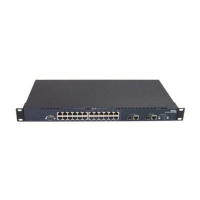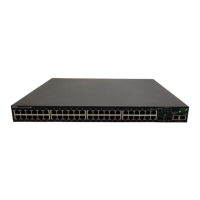BigIron RX Series Configuration Guide 201
53-1002253-01
Configuring forwarding parameters
7
Configuring a static IP route
To configure an IP static route with a destination address of 192.0.0.0 255.0.0.0 and a next-hop
router IP address of 195.1.1.1, enter the following.
BigIron RX(config)# ip route 192.0.0.0 255.0.0.0 195.1.1.1
To configure a default route, enter the following.
BigIron RX(config)# ip route 0.0.0.0 0.0.0.0
To configure a static IP route with an Ethernet port instead of a next-hop address, enter a command
such as the following.
BigIron RX(config)# ip route 192.128.2.69 255.255.255.0 ethernet 4/1
The command configures a static IP route for destination network 192.128.2.69/24. Since an
Ethernet port is specified instead of a gateway IP address as the next hop, the device always
forwards traffic for the 192.128.2.69/24 network to port 4/1.
To configure an IP static route that uses virtual interface 3 as its next hop, enter a command such
as the following:
BigIron RX(config)# ip route 192.128.2.71 255.255.255.0 ve 3
Syntax: ip route <dest-ip-addr> <dest-mask> | <dest-ip-addr>/<mask-bits>
<next-hop-ip-addr> | ethernet <slot/port> | ve <num>
[<metric>] [tag <num>] [distance <num>]
The <dest-ip-addr> is the route’s destination. The <dest-mask> is the network mask for the route’s
destination IP address. Alternatively, you can specify the network mask information by entering /
followed by the number of bits in the network mask. For example, you can enter 192.0.0.0
255.255.255.0 as 192.0.0.0/.24.
The <next-hop-ip-addr> is the IP address of the next-hop router (gateway) for the route.
For a default route, enter 0.0.0.0 0.0.0.0 xxx.xxx.xxx.xxx (use 0 for the <mask-bits> if you specify
the address in CIDR format).
If you do not want to specify a next-hop IP address, you can instead specify a port or interface
number on the device. The <num> parameter is a virtual interface number. The <slot/port> is the
port’s number of the device. If you specify an Ethernet port, the device forwards packets destined
for the static route’s destination network to the specified interface. Conceptually, this feature
makes the destination network like a directly connected network, associated with a device
interface.
The port or virtual interface you use for the static route’s next hop must have at least one IP address
configured on it. The address does not need to be in the same subnet as the destination network.
The <metric> parameter specifies the cost of the route and can be a number from 1 – 16. The
default is 1.
If you specify 16, RIP considers the metric to be infinite and thus also considers the route to be
unreachable.
The tag <num> parameter specifies the tag value of the route. Possible values: 0 - 4294967295.
Default: 0.

